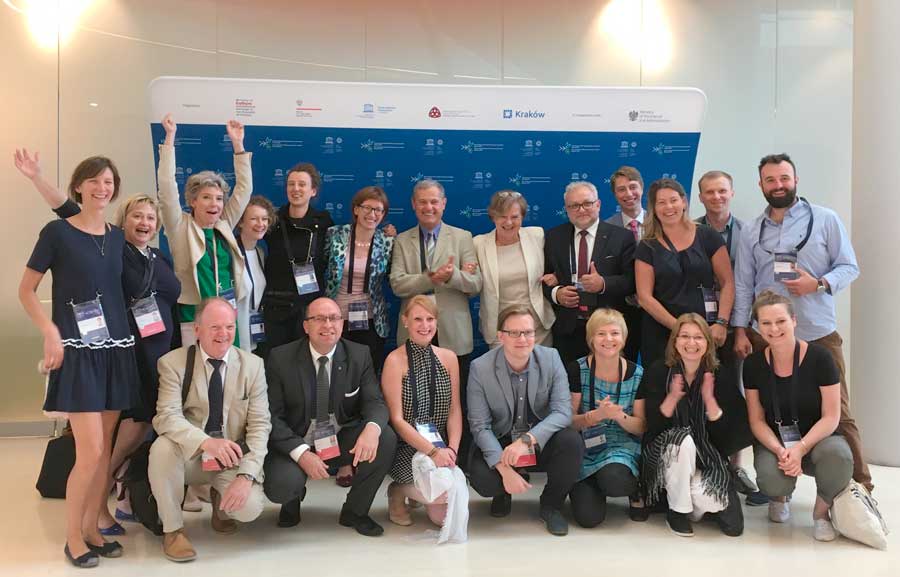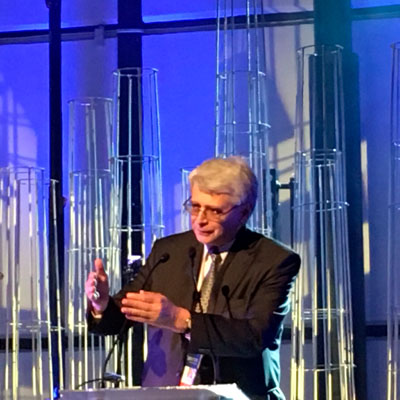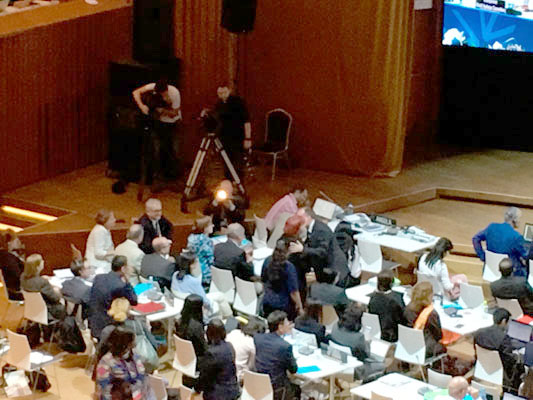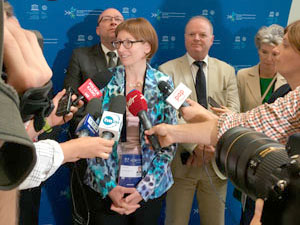From our media representative at UNESCO’s 41st Meeting of the World Heritage Committee

Poland’s Success – World Heritage Listing of the Tarnowskie Góry Lead-Silver-Zinc Mine and its Underground Water Management System
Krakow hosted the 41st UNESCO World Heritage Meeting between the 2-12 July 2017 at the International Congress Centre (ICE Krakow).

fot. Anne Marie Lopez
On 9 July 2017, the Tarnowskie Góry Lead-Silver-Zinc Mine and its Underground Water Management System was inscribed as a UNESCO World Heritage Site pursuant to the Convention Concerning the Protection of the World Cultural and Natural Heritage on the basis of criteria (i), (ii) and (iv) for the assessment of Outstanding Universal Value.
The International Convention provides for the protection of the cultural and natural heritage of Outstanding Universal Value. Outstanding Universal Value means cultural and/or natural significance which is so exceptional as to transcend national boundaries and to be of common importance for present and future generations of all humanity.
Poland’s nomination for World Heritage Listing was found to:
(i) represent a masterpiece of human creative genius;
(ii) exhibit an important interchange of human values, over a span of time or within a cultural area of the world, on developments in architecture or technology, monumental arts, town-planning or landscape design; and
(iv) be an outstanding example of a type of building, architectural or technological ensemble or landscape which illustrates (a) significant stage(s) in human history.
NOMINATION PROCEEDINGS — Consideration of the Nomination
The Chair for consideration of this nomination was the Ambassador of Portugal, H. E. Mr José Filipe Mendes Moraes Cabral. As a matter of procedure he invited ICOMOS to present this nomination.
The Chair first gave the floor to the Secretary of ICOMOS, Mr Balsomo, who noted factual errors in the evaluation report of ICOMOS. These were significant and according to the State Party of Portugal addressed the many challenges identified by ICOMOS. The relevance of this is seen below.
ICOMOS – Advisory Body
ICOMOS considered the nomination and the criteria supporting the Outstanding Universal Value of the Tarnowskie Góry Lead-Silver-Zinc Mine and its Underground Water Management System. ICOMOS did not consider sufficient information had been provided to justify inscription under the four criteria and recommended deferral of the nomination for the State Party to revisit the nomination on the ground of further research and documentation, to build a robust case for the world heritage listing, deepen the description of the property and its attributes based on additional documentation and further expand the comparative analysis.

DELIBERATIONS — The Vote
The 21 States Parties who formed the World Heritage Committee were asked to present their comments.
Many of the States recommended the inscription on the bases of criteria (i),(ii) and (iv) but did not consider that criterion (iii) had been met.
I note some of the significant comments:
The Member State of Turkey was of the view that the construction of a well functioning mining system within a technically challenging flat terrain is a testimony to human genius and creativeness. Turkey supported inscription on the basis of criteria (i) (ii) and (iv).
The Philippines welcomed the inscription on the grounds “it demonstrates human creative genius in turning the unwanted presence of water in the mines into an opportunity to supply water to towns and industries, that it exhibits pioneering technical interchanges and transfers of technology between this region — Continental Europe and Great Britain, that it bears witness to the wider technological and industrial culture of Silesia and after 500 year old multicultural mining tradition of the area, and that Tarnowskie Góry is a unique technical complex that combines a mining operations and water supply development in the Silesian context between the 16th and 20th centuries.”
Croatia was very critical of ICOMOS evaluation and advised that “Poland has given a response to those requests [of ICOMOS] and its diligent factual errors report convinced us that the comparative analysis was indeed conclusive as to the exceptionality of the property”. Croatia also found ICOMOS request for 3D scanning of the entire underground property to be prohibitive in terms of time and cost and saw no valid purpose in this recommendation as Poland had already supplied full and accurate plans of the property. Croatia was of the firm view that criteria (i),(ii) and (iv) have been met but agreed with the advisory body that (iii) has not been met yet.
Jamaica considered that the this industrial nomination fills a gap in the World Heritage List and other countries urged Poland to undertake the recommendations made by ICOMOS.
Questions were asked by three States Parties — Angola, Cuba and Finland. These were addressed to the State Party and ICOMOS. The questions concerned the addition of the water tower in the Kaehler Shaft to the nomination and questions about criterion (i).
Poland responded that it had been asked to consider the addition of the water tower during the technical evaluation mission and was happy to do so and that it believed that criterion (i) was met as the “principal values of the nominated property lies in the underground system which manifests the integrated mining and water management network” and “the monumental underground mining and water management system is a masterpiece of hydraulic engineering and exceptional expression of the technical creativity.”
AMENDMENTS
Amendments to the nomination were made by Turkey, Azerbaijan, the Republic of Korea and Croatia.
These were approved by the World Heritage Committee. All amendments to Item 8B.25 were adopted as amended.
THE DECISION — 41 Com 8B.25 Inscription o n The World Heritage List
Poland’s nomination was voted for inscription with some amendments to the original nomination. Criteria (i), (ii) and (iv) were found to justify the inscription.
Recommendations were also made for the republic of Poland to consider. These included finalising and implementing legal protections, setting up multidisciplinary scientific committees and developing an archaeological investigation programme.
The decision for inscription and recommendations can be found at http://whc.unesco.org/en/decisions/6897/
REPUBLIC OF POLAND’s THANK YOU
 Dr. Katarzyna Piotrowska of the National Heritage Institute, who was the expert in charge of the team responsible for organising the 41st Session gave thanks from the Republic of Poland to the World Heritage Committee for their decision and extended their thanks from the Tarnowskie Góry Land Lovers’ Association who for over 60 years have taken care of the mining heritage of the region, the Tarnowskie Góry Municipality, Katowice Regional Government, the National Heritage Board of Poland and all the parties involved and responsible for the protection, conservation and presentation of the world heritage property.
Dr. Katarzyna Piotrowska of the National Heritage Institute, who was the expert in charge of the team responsible for organising the 41st Session gave thanks from the Republic of Poland to the World Heritage Committee for their decision and extended their thanks from the Tarnowskie Góry Land Lovers’ Association who for over 60 years have taken care of the mining heritage of the region, the Tarnowskie Góry Municipality, Katowice Regional Government, the National Heritage Board of Poland and all the parties involved and responsible for the protection, conservation and presentation of the world heritage property.
Poland’s expert explained that “Water, the main feature of the property is an obstacle in the development of mining and at the same time an essential condition for life and development“ and concluded by stating “Through this nomination and inscription we pay tribute to work and wisdom of past generations thanks to whom our and future generations can live and prosper.”
Anne Marie Lopez




 USD
USD  AUD
AUD  CAD
CAD  NZD
NZD  EUR
EUR  CHF
CHF  GBP
GBP 





